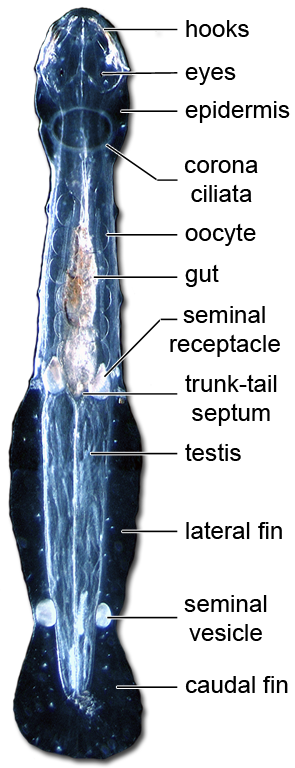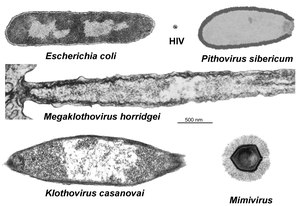Chaetognatha
Chaetognatha, also known as arrow worms, are a phylum of predatory marine invertebrates that play an important role in the oceanic food chain. These small, transparent, planktonic creatures are characterized by their elongated bodies and the presence of grasping spines near their mouths, which they use to capture prey. The name "Chaetognatha" is derived from the Greek words chaite (hair) and gnathos (jaw), referring to these distinctive spines.
Description
Chaetognaths are typically a few millimeters to a few centimeters in length, with a body divided into three distinct regions: the head, trunk, and tail. The head carries the grasping spines or chaetae, which are used for hunting, while the trunk and tail house the digestive and reproductive organs, respectively. Their bodies are covered in a transparent cuticle, making them nearly invisible in the water, an advantage against both predators and prey.
Habitat and Distribution
Chaetognaths are found in all the world's oceans, from the surface to the deep sea. They inhabit a wide range of environments, including polar, temperate, and tropical waters. Some species are benthic, living near the ocean floor, but the majority are planktonic, drifting with ocean currents.
Ecology and Behavior
As voracious predators, chaetognaths play a significant role in marine ecosystems. They feed primarily on other planktonic organisms, such as copepods, crustaceans, and small fish larvae, using their rapid, darting movements and grasping spines to capture prey. Chaetognaths are, in turn, preyed upon by larger marine animals, including fish and cephalopods.
Reproduction among chaetognaths is diverse, with some species being hermaphroditic and others having separate sexes. Fertilization can be internal or external, depending on the species. They have a rapid life cycle and can produce multiple generations per year, contributing to their abundance in marine plankton communities.
Taxonomy
The phylum Chaetognatha is divided into two orders: Sagittoidea and Phragmophora. These are further subdivided into several families and genera. The classification of chaetognaths has been challenging due to their simple morphology and the lack of fossil records, but molecular studies have begun to provide insights into their evolutionary relationships with other marine organisms.
Research and Importance
Chaetognaths are of interest to scientists for several reasons. They are considered excellent indicators of water masses and ocean currents due to their specific habitat preferences. Additionally, their position in the marine food web makes them important for studies on energy transfer and ecosystem dynamics. Understanding the biology and ecology of chaetognaths is crucial for predicting changes in marine biodiversity and the impacts of climate change on oceanic ecosystems.
Transform your life with W8MD's budget GLP-1 injections from $125.
W8MD offers a medical weight loss program to lose weight in Philadelphia. Our physician-supervised medical weight loss provides:
- Most insurances accepted or discounted self-pay rates. We will obtain insurance prior authorizations if needed.
- Generic GLP1 weight loss injections from $125 for the starting dose.
- Also offer prescription weight loss medications including Phentermine, Qsymia, Diethylpropion, Contrave etc.
NYC weight loss doctor appointments
Start your NYC weight loss journey today at our NYC medical weight loss and Philadelphia medical weight loss clinics.
- Call 718-946-5500 to lose weight in NYC or for medical weight loss in Philadelphia 215-676-2334.
- Tags:NYC medical weight loss, Philadelphia lose weight Zepbound NYC, Budget GLP1 weight loss injections, Wegovy Philadelphia, Wegovy NYC, Philadelphia medical weight loss, Brookly weight loss and Wegovy NYC
|
WikiMD's Wellness Encyclopedia |
| Let Food Be Thy Medicine Medicine Thy Food - Hippocrates |
Medical Disclaimer: WikiMD is not a substitute for professional medical advice. The information on WikiMD is provided as an information resource only, may be incorrect, outdated or misleading, and is not to be used or relied on for any diagnostic or treatment purposes. Please consult your health care provider before making any healthcare decisions or for guidance about a specific medical condition. WikiMD expressly disclaims responsibility, and shall have no liability, for any damages, loss, injury, or liability whatsoever suffered as a result of your reliance on the information contained in this site. By visiting this site you agree to the foregoing terms and conditions, which may from time to time be changed or supplemented by WikiMD. If you do not agree to the foregoing terms and conditions, you should not enter or use this site. See full disclaimer.
Credits:Most images are courtesy of Wikimedia commons, and templates, categories Wikipedia, licensed under CC BY SA or similar.
Contributors: Prab R. Tumpati, MD





